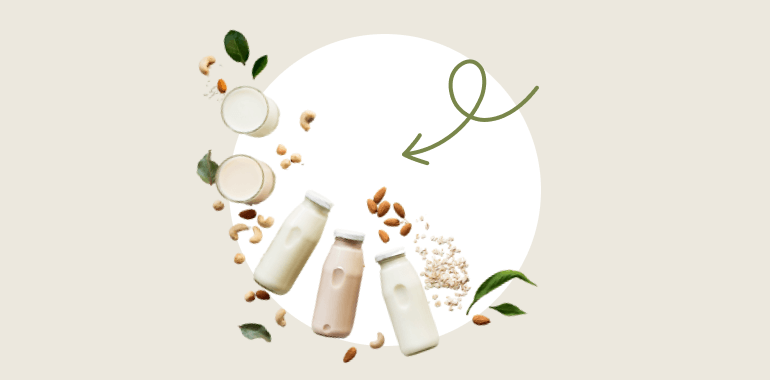Table Of Contents
Introduction: What Are the General Differences Between Oat Milk and Almond Milk?
Oat milk and almond milk are both dairy-free alternative milk that has grown in popularity in recent years due to their flavorful taste and versatility. The main difference between these two non-dairy kinds of milk is their individual flavor profiles. Oat milk boasts a light and creamy oaty flavor, while almond milk has a nutty, earthy taste.
Additionally, oat milk tends to be richer in terms of texture, making it perfect for cereal or oatmeal. At the same time, many find almond milk preferable for baking recipes as it produces a fluffier texture. Nutritionally speaking, both are good sources of protein. However, almond milk typically contains more overall vitamins and minerals per serving than oat milk.
It’s important to remember that the nutrient content can vary between brands, so make sure to read the labels before you decide which one to choose!
Also, read – Why You Should Start Eating Vegetables For Breakfast
Oat Milk vs Almond Milk Taste
Popular dairy-free milk options include almond and oat milk. They are both perfect for various kinds of recipes because they each have a distinct flavor and texture.
Both oat milk and almond milk don’t quite taste and feel like regular cow’s milk, but that is more of an adjustment than a drawback. Oat milk tastes starchy, while almond milk tastes like almonds and is thinner than conventional cow’s milk.
Compared to almond milk, oat milk tastes sweeter and has more carbohydrates, making it a better choice for foamy beverages and baked products. However, almond milk is perfect for smoothies, cereals, and savory dishes because of its nutty flavor and thinner consistency.
General Taste: Oat milk has a naturally sweet flavor and a creamy consistency, whereas almond milk has a mildly nutty flavor and a watery texture.
Almonds are used to make, you guessed it, almond milk! After being soaked in water, the almonds are mashed into a paste. Then, the almond milk is made by straining this paste after adding more water. Similar methods are used to make oat milk. However, oats are used in place of almonds.
What does this entail for the flavor, then? Some people adore the nutty flavor of almond milk, while others find it to be a little odd. Similar to cow’s milk in flavor, oat milk is blander.
- Oat milk is the way to go if you’re seeking milk that tastes similar to cow’s milk.
- Almond milk, on the other hand, might be the best option for you if you’re searching for something with a little more flavor.
What Does Oat Milk Taste Like – We Have a Detailed Answer!
Water and whole oats are the two main components used to make oat milk. Whole oats are soaked in water for several hours without going into much detail. The whole oats soak up the water in the environment during this period.
The whole oats are then crushed and strained once the water has sufficiently been absorbed. This is the purest kind of oat milk that we are familiar with. Then, other brands or businesses will add their components to create oat milk that is even more distinctive.
- A slight oat aftertaste distinguishes oat milk from conventional cow milk in terms of flavor. Oat milk will differ less significantly in flavor than in appearance. More details are provided below.
Oat milk is sometimes sweeter and smoother than cow’s milk. It coats your mouth exquisitely. Remember that the fat you receive may differ from regular, creamy milk.
However, the brand of oat milk that you want can control the density of its oat milk. And as a result, they have some influence over how creamy the oat milk turns out.
Does milk have sugar? Natural sugars are present in oats. These are fantastic and generally healthier than the sweeteners added to milk. The distinction is that sugars are not excessively sweet because they are converted to carbs.
You’re thinking incorrectly if you believe you cannot obtain the same texture as conventional cow’s milk. It differs from the standard nut or almond milk. Instead, oat milk is unique because even a tiny amount can provide a creamy mouthfeel.
A lot of people are curious as to whether oat milk tastes like oatmeal or oats. Oat milk has a distinct flavor of its own, much to how almond milk doesn’t taste precisely like almonds. You won’t be far off if you picture adding a little vanilla and brown sugar after draining the milk from your bowl of oatmeal.

What Does Almond Milk Taste Like & Why It Is So Good
If you have never eaten almond milk before, it tastes primarily of almonds. We’re here to let you know that’s only partially accurate. In actuality, it tastes more like cereal milk or sweet dairy milk than anything else!
Cinnamon, vanilla, chocolate, and honey are typical flavor elements. Of course, a lot relies on the brand of sweetened almond milk you choose to consume.
One of the main criticisms about non-dairy milk is that it frequently lacks the creamy feeling of cow’s milk and can occasionally have a watery texture. Almond milk, though, is an exception to this rule.
Does milk have sugar? As previously mentioned, numerous almond milk products on the market include sugar. However, those with no sugar are low in carbohydrates. Milk has a high protein and fat content compared to its carbohydrate amount. It does not raise blood sugar levels because of this.
The texture of almond milk is smooth and creamy, similar to that of cow’s milk. Therefore, it is enjoyable to sip or blend into a latte or other beverage. If the first brand doesn’t wow you, it’s advised that you try several others because different brands have varied textures.
Although almond milk has a very mild flavor, it is nevertheless a little sweet, even when it is unsweetened. The natural sweetness of almonds is where this sweetness originates.
It all depends on your particular preferences, but it is still a reasonably mild-tasting addition to coffee that you can appreciate.
Previously posted – Is Kombucha Good For Weight Loss
Calories in Oat Milk vs Almond Milk
Oat milk contains 130 calories per cup, 15 grams of carbohydrates, 2.5 grams of fat, 0 grams of saturated fat, 2 grams of fiber, 4 grams of protein, and 35 percent of your daily necessary calcium intake and 25 percent of your daily recommended vitamin D intake.
Unsweetened almond milk has about 39 calories per serving. However, the total calorie count will vary depending on the brand, flavor, and whether it’s sweetened or not.
Almond milk’s calories and carbs rise if you purchase flavored or sweetened kinds (all stats below from the USDA for 1 cup of milk).
- Compared to almond milk, oat milk has a lot more calories. However, almond milk might be a better option to cut calories because it has only 60 calories per serving compared to its 120-calorie counterpart.
Nutritional Value of Oat Milk vs Almond Milk
Because different producers employ different ingredients, it is difficult to compare the nutritional value of various milk replacements. The following is a broad comparison, but you’ll need to read the labels to see how multiple brands compare.
1. Carbohydrates
Out of all the plant-based alternatives, oat milk has the most carbohydrates. Around 16g of carbohydrates are included in an eight-ounce glass of oat milk.
Oat milk is not the ideal choice for you if you’re following a ketogenic diet or otherwise trying to consume a few carbohydrates. If it is unsweetened, almond milk may only have 1g of carbs per serving.
2. Protein
Almond milk and other nut milk provide a little more protein than oat milk, but not enough to qualify as a rich source of protein. It is a partial protein since it lacks all nine essential amino acids. Compared to almond milk’s meager 1g of protein, one cup has 2-3 grams.
Pea milk might be a better choice if you’re seeking plant-based milk richer in protein. Pea milk contains about 8g of protein per serving, comparable to the amounts found in cow’s milk and soy milk.
3. Fat
Oat milk has 5 grams of fat compared to 2.5 grams of almond milk, which is a two-fold increase in fat content.
This difference can be balanced out by making healthy choices in other areas. For example, using oat milk to replace cream in coffee or dishes where the prominent flavor should stay unchanged could contribute positively to one’s diet.
4. Oat milk vs almond milk for weight loss
With so many milk alternatives now available at supermarkets, it’s a great place to begin finding healthier substitutes and determining which milk is the better choice depending on individual needs and preferences.
The two most popular dairy-free alternatives available today are oat and almond milk. Oat milk contains more protein than almond milk; however, almond milk is low in calories and rich in vitamins essential for muscle growth and development.
Ultimately, the decision of whether to opt for oat or almond milk comes down to personal preference, as there isn’t one that will definitively bring about weight loss over the other.
5. Micronutrients
Many non-dairy kinds of milk have calcium, vitamin B12, and vitamin D added as supplements. It can be challenging to consume enough nutrients if you’re a vegetarian or vegan without consuming fortified meals. To maximize your intake of a specific nutrient, start reading nutritional panels to see which brands have the highest nutrient levels.
Previously posted – Is Tofu Good for Weight Loss? A Definitive Answer with Рroven Reasons
How Many Carbs in Almond Milk?
- Unsweetened almond milk is an excellent choice for a nutritious keto diet because it only has 1.4 grams of carbs per cup (240 mL), 37% of the DV for calcium, and 46% of the DV for vitamin E.
However, since sweetened almond milk has 16 grams of carbs and 15 grams of sugar, it is significantly more challenging to incorporate into a ketogenic diet.
Your ability to eat low-carb fruits and vegetables and other nutrient-dense sources of carbohydrates throughout the day will be significantly hampered if you choose to consume sweetened variants.
What are the Nutritional Benefits of Drinking Almond or Oat Milk?
Almond Milk
Almond milk’s micronutrients have many positive health effects. For those who cannot consume cow’s milk due to lactose intolerance or sensitivity, almond milk offers a healthy alternative.
- Could Improve Heart Health
More than 16mg of vitamin E is present in one cup of almond milk. In addition, antioxidative stress, which may improve heart health and shield your body against conditions like cancer, arthritis, and diabetes, is thought to be prevented by vitamin E.
- Bone Health
Almond milk contains 482 mg of calcium per serving, and studies have shown that calcium supports the maintenance of healthy bones. It is necessary for healthy neuron and muscle function as well.
- Promote Skin Health
Almond milk contains vitamin E, which may support healthy skin. This vitamin’s capacity to counteract UV radiation by scavenging free radicals has been related to enhanced skin health.
- Almond milk is good for diabetics
For diabetics, almonds and almond milk may have some health advantages. These nuts may promote satiety, help regulate blood sugar, and aid in weight control because they are high in protein, healthy fats, and fiber but low in carbohydrates.
Previously posted – Paleo vs. Keto: Which Diet Will Work Best…
Oat Milk
Many of the same health advantages of ordinary milk also apply to oat milk. For instance, they both contain the same number of calories per cup. Oat milk also contains significant amounts of calcium and vitamin D, just like cow’s milk. Therefore, having one or two glasses daily is a terrific strategy for adults and children to develop strong bones.
- Promotes satiety
Oat milk immediately fills you up and helps keep you feeling full for an extended time due to its high levels of protein and fiber. This can support weight loss and help with better appetite management.
- Provides significant iron levels
10% of your daily necessary iron intake can be found in one cup of oat milk. This makes it a healthy supply of iron for vegans and vegetarians who could miss out on other sources of iron. Anemia can be avoided by having adequate iron levels, which aid in healthy red blood cell synthesis.
- Helps control cholesterol levels
Oats include beta-glucan, a form of soluble fiber that aids in maintaining normal cholesterol levels. When oats are processed into oat milk or other oat beverages, beta-effects glucan for decreasing cholesterol is retained.

Is Almond Milk Gluten Free: Special Diet Notes
Since almonds are inherently gluten-free, most producers don’t experience problems with gluten cross-contamination.
However, certain flavorings in almond milk contain chemicals that contain gluten. Read the label carefully before purchasing flavored almond milk to ensure it’s a good choice.
Is Oat Milk Keto, or Can You Drink Oat Milk on Keto?
Sadly, oat milk isn’t keto-friendly because it has too many carbs. So it still needs to be a low-carb food, even if you purchase the unflavored or unsweetened variety.
- Unsweetened oat milk has roughly 12 grams of net carbs per eight-ounce serving, which is half or more of the daily net carb limit for a keto diet.
Keep in mind that you must consume less than 20 to 25 grams of carbohydrates per day, or less than 5% of your daily caloric intake, to remain in ketosis.
Tell Me the Difference: Almond Milk vs Cow Milk
Cow’s milk is one of the world’s most nutrient-dense foods and one of the first superfoods.
Cow milk is a remarkably healthy option because it contains over 15 critical elements and a natural balance of carbohydrates, protein, and lipids. Almond milk is an excellent plant-based substitute for people who cannot or do not want to consume cow’s milk.
Almond milk contains less protein, fat, carbs, and micronutrients than cow’s milk because water is its main component.
Soy Milk vs Almond Milk – Factors to Consider
The closest equivalent to cow milk is soy milk, which has about 95 calories and 7 to 12 grams of protein per cup. Almond milk has the fewest calories (30 to 50) but has the fewest grams of protein (1 per cup).
Glycosides, a class of phytonutrients found in soy milk, have been demonstrated to have anticancer effects. A source of heart-healthy polyunsaturated fat is soy milk.
Contrarily, almond milk provides a good source of vitamins A and E and heart-healthy monounsaturated fats. As mentioned, the lowest number of calories also means the fewest nutrients.
Coconut Milk vs Almond Milk: Which Is Healthier?
- Almond milk is produced from almonds, while coconut milk is made from the flesh of coconuts. Both are alternatives to non-dairy milk.
- Coconut milk is creamier and more affluent than almond milk because it contains more fat. On the other hand, almond milk is more adaptable than coconut milk because it has a softer flavor.
Compared to almond milk, coconut milk contains more calories and saturated fat. However, almond milk is a greater source of vitamins and minerals, such as calcium, potassium, and vitamin E.
My name is Barbara Kovalenko. I hold a Bachelor's degree in Human Nutrition from Bogomolets National Medical University in Ukraine and a Master's degree from Boston University in the United States. Over the past few years, I have gained valuable experience as a nutritionist and have since decided to share my knowledge and expertise with a wider audience. Currently, I am working as a nutritional consultant with the Lasta app.










My brother recommended I might like this web site. He was once totally right. This put up actually made my day. You can not imagine just how much time I had spent for this information! Thank you!
Thank you for this informative comparison between oat milk vs almond milk! Your detailed breakdown of their taste, nutritional content, and uses is incredibly helpful for making an informed choice.
Hello, Jessica 👋
Happy to help with the info comparison of oat milk vs almond milk!